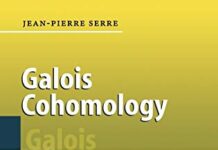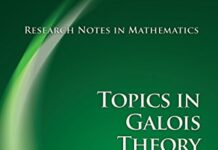
Ebook Info
- Published: 2000
- Number of pages: 83 pages
- Format: PDF
- File Size: 3.14 MB
- Authors: Jean-Pierre Serre
Description
These short notes, already well-known in their original French edition, present the basic theory of semisimple Lie algebras over the complex numbers. The author begins with a summary of the general properties of nilpotent, solvable, and semisimple Lie algebras. Subsequent chapters introduce Cartan subalgebras, root systems, and linear representations. The last chapter discusses the connection between Lie algebras, complex groups and compact groups. The book is intended to guide the reader towards further study.
User’s Reviews
Editorial Reviews: Review From the reviews of the French edition:”…the book is intended for those who have an acquaintance with the basic parts of the theory, namely, with those general theorems on Lie algebras which do not depend on the notion of Cartan subalgebra. The author begins with a summary of these general theorems and then discusses in detail the structure and representation theory of complex semisimple Lie algebras. One recognizes here a skillful ordering of the material, many simplifications of classical arguments and a new theorem describing fundamental relations between canonical generators of semisimple Lie algebras. The classical theory being thus introduced in such modern form, the reader can quickly reach the essence of the theory through the present book.” (Mathematical Reviews) From the Back Cover These short notes, already well-known in their original French edition, give the basic theory of semisimple Lie algebras over the complex numbers, including classification theorem. The author begins with a summary of the general properties of nilpotent, solvable, and semisimple Lie algebras. Subsequent chapters introduce Cartan subalgebras, root systems, and linear representations. The last chapter discusses the connection between Lie algebras, complex groups and compact groups; it is intended to guide the reader towards further study.
Reviews from Amazon users which were colected at the time this book was published on the website:
⭐This book is really dense, and not recommended for the first encounter with Lie algebras. However, it contains exactly the things one ends up remembering after a year’s course, so it’s great for review, reminder, or a reference book. The exposition, as usual for Serre, is very clear.
⭐This book is intended as a short concise overview of the theory of complex semisimple Lie algebras. Inspite of its small volume, this text is far from being of easy lecture, since it assumes the knowledge of some basic facts concerning Lie algebras, as well as associative algebras. Indeed the first chapters are a résumé, without proofs, of some basic theorems of Lie algebras. This concerns solvable and nilpotent Lie algebras, as well as some generic results on semisimple algebras (results that do not involve Cartan subalgebras).The proper exposition begins with the third chapter, dealing with Cartan subalgebras. Two fundamental facts are exposed in this chapter: existence and conjugacy of these subalgebras. The existence is proved by exhibiting the classical construction by means of regular elements, i.e., elements of the algebra whose annihilator is of minimal dimension. The conjugacy of Cartan subalgebras, which enables us to define the numeric invariant called rank, is developed in analogous way to the book of Chevalley [Théorie des Groupes de Lie, 1951]. Chapter four is devoted to the study of the complex simple Lie algebra of rank one, sl(2,C). This algebra plays the key role in the study of semisimple algebras and their representations, which justifies a separated treatment. The irreducible representations of sl(2,C) are obtained.The root theory is introduced in the following chapter. Here the first innovation is made, namely, developing the root systems before dealing with the Cartan decomposition. In particular, no inner product has been used yet. Root systems are defined over a real vector space V, and the Weyl group is defined as the group generated by certain involutions associated to the roots [one will observe observe the similarity of this definition and the theory of Coxeter groups]. The inner product on V is obtained as an inner product which is invariant under the Weyl group. Bases of roots and their elementary properties are developed, and how to go from a basis to another by emans of the Weyl group [it is supposed that the root system is reduced, for nonreduced systems see for example the sixth chapter of Bourbaki: Algèbres de Lie, Hermann 1967]. Then it follows the notion of Cartan matrix (obtained from the inner product previously defined), and the associated Dynkin diagram. All admissible Dynkin diagrams are enumerated, and their corresponding root systems enumerated. Chapter six begin with the classical Weyl theorems, and the Cartan decomposition of a semisimple Lie algebra is obtained. From this the root system associated to the algebra follows naturally. The core of the chapter is the existence and uniqueness proofs of semisimple Lie algebras corresponding to a root system. As an appendix, a theorem showing how to construct semisimple Lie algebras from root systems by means of generators and relations [that is, using presentations]. This result is of extreme importance, and constitutes one of the germs that lead to the notion of Kac-Moody algebras in 1968. The next chapter is a standard treatment of representation theory of semisimple Lie algebras. The existence of dominant weights is shown, from which the (canonical) bijection between dominant integral forms and the finite dimensional irreducible modules follows. The Weyl character formula is also presented, but without proof.The final chapter presents some important results of compact groups, intended to facilitate the lecture of more advanced texts [like the book of Pontryaguin, for example].Resuming, an excellent text that presents a good insight to the theory of complex semiimple algebras. It should however be said that probably this book is not convenient for a first contact with these structures, due to its comprised presentation and the complete absence of exercises or many examples [this applies at least to the original french edition]. Actually, some acquaitance with Lie theory is implictly supposed through the text.
⭐This is an excellent and clear written textbook
⭐
⭐
Keywords
Free Download Complex Semisimple Lie Algebras in PDF format
Complex Semisimple Lie Algebras PDF Free Download
Download Complex Semisimple Lie Algebras 2000 PDF Free
Complex Semisimple Lie Algebras 2000 PDF Free Download
Download Complex Semisimple Lie Algebras PDF
Free Download Ebook Complex Semisimple Lie Algebras




